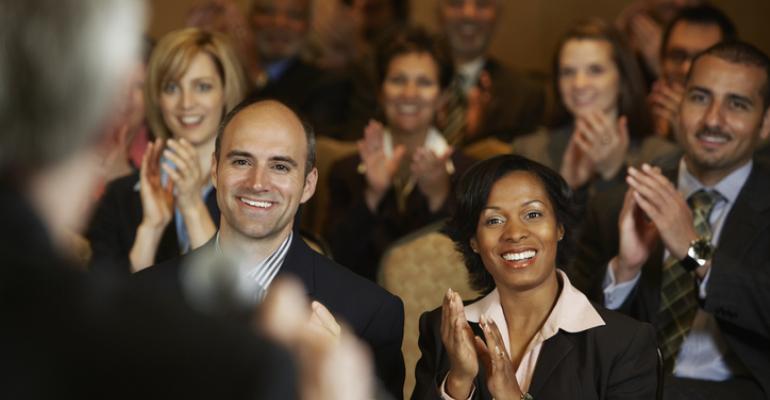It’s that time of year again when corporate-event planners must focus on creating a sales kickoff meeting that hits the mark for the reps as well as the executive team. No pressure, right?
In a recent MeetingsNet webinar, Jason Jenkins, a senior enterprise sales executive for Cvent, noted that the primary goals of an SKO should be to engage reps and make them feel valued, celebrate their recent success, provide them with tools and skills to reach their next quota, and create an atmosphere where they can share perspectives, build trust, and commit to year-round support of each other.
For 2025, one other goal that’s especially important is “to maintain corporate culture and morale in the face of uncertainty,” Jenkins said. With so many reps, managers, and executives across corporate America working remotely, the SKO is the most powerful moment of the year for achieving this goal.
Deciding Who Attends in Person
The decision on which reps will participate on site and which will attend virtually should be made clear to the sales team well ahead of time, according to Lauren Platia, senior manager of event marketing for software maker Appian.
If there are reps who will attend the SKO virtually, Platia stressed that their experience must be unique, not just during the event but in the run-up to the event as well. First, an online moderator, live Q&A, and exclusive live or recorded video segments are important elements for engaging remote attendees, as are opportunities to interact with each other when networking sessions are happening on site. And to build excitement among remote attendees ahead of an SKO, Platia recommended sending gifts that are only for that audience.
Creating a Theme with Staying Power
“Make sure to have a theme that is relevant, inspiring, and will have year-round use,” said Jen Schlueter, senior director of business transformation for Cvent. “It should be woven into other events and activities through the year.” For instance, Cvent creates Slack channels connected to their SKO’s theme that are active all year long.
In addition, “music is important for reinforcing the theme because it makes for easy, strong recollection,” added Jenkins. And while “some reps might find some of your theme-related elements a bit cheesy, you should not pander to those few” because the overall benefit of reinforcing the theme in different, energetic ways is significant.
Delivering on Expectations
Get input from reps during the planning process; doing so can help them to feel like they’re part of a conversation with executives both before and during the event rather than “simply being spoken to,” said Jenkins. With their input, “you can engage and excite them on site with what is most important to them.”
And what are those priorities? Typically, reps want to understand the larger picture through a SWOT analysis; hear “from the field” stories from colleagues about their challenges, solutions, and successes; learn from people from outside their industry who have overcome difficult challenges; and have opportunities to find a mentor or be a mentor.
Another element that’s welcome by sales reps is gamification and light competition. Platia noted that while “we don’t want reps to be on their phones very much on site, we do use it for polling them on the issues being discussed, and we use a leaderboard that shows each rep’s ‘engagement score.’” Those who score the highest each day and across the entire event win prizes.
Other contests can be conducted for using the event app, participating in scavenger hunts, and posting entertaining photos and videos. In the physical realm, low-risk competitive options include billiards, bocce, cornhole, putt-putt golf, pickleball, and karaoke, among many others.
These activities lead into the larger, very important goal of celebrating reps’ achievements during an SKO. To ensure that the recognition activities highlighting reps’ performance are effective, planners should conduct pre-event surveys to see what reps value most when being recognized themselves, and when celebrating the achievements of their colleagues.
Lastly, from a logistical standpoint, “make reps’ preparation for attending the event as easy as possible,” Jenkins added. “Provide a detailed schedule with dress codes for each part of the event.”
Post-Event Feedback and ROI
Hearing from reps about which speakers, presenters, and sessions they liked the most and least is critical for assessing their priorities and building other sales events throughout the year, as well as next year’s SKO. And to maximize participation in post-event surveys, planners could offer reps unique gifts or other rewards.
In the months after the SKO, feedback from customers regarding the quality of their interactions with reps can help planners and executives determine if the key themes and skills delivered at the event have taken root. Of course, the most important metrics for measuring the effectiveness of the SKO are sales figures and employee-retention percentages. Together, the rep feedback, customer feedback, and sales and retention metrics will inform the executive team and the planning team on what the priorities should be for the next SKO.
To learn more from the three sales-meeting veterans who conducted the MeetingsNet webinar, watch the entire 60-minute video here.





